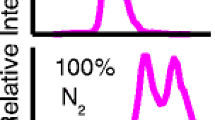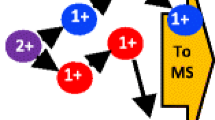Abstract
Using Fourier-Transform ion gate modulation technique, we compare the ability of the tri-state ion shutter (3S-IS) to the two-state ion shutter (2S-IS) in separating three pairs of isomeric peptide including 1.Gly-Arg-Gly-Asp-Ser (GRGDS) / Ser-Asp-Gly-Arg-Gly (SDGRG); 2.Sar-Arg-Gly-Asp-Ser-Pro (SRGDSP) / Gly-Arg-Gly-Asp-Thr-Pro (GRGTP); 3.Kemptide / (Val6, Ala7)-Kemptide using electrospray ionization and ion mobility spectrometry. Mobility separation was evaluated for peptide individually and as simple mixtures. Baseline resolution of both singly and doubly charged ions of the isomeric pentapeptide mixture of GRGDS / SDGRG was attainable with the described IMS system using the 3S-IS configuration, illustrating the capacity of the present instrument to resolve isomeric compounds with differences in ion neutral collision cross section (CCS) of less than 1% for the singly charged ions. However, with the 2S-IS, both singly and doubly charged ions of the same peptide mixture were unresolved in the mobility domain. To our knowledge, this is the first-time baseline separation has been reported for the singly charged ions of the isomeric reversed sequence pentapeptide mixture using Fourier transformed drift tube IMS with nitrogen as the drift gas. For all the peptide mixtures, the ion counts for the ion mixture recorded with the 3S-IS were substantially higher (> 50%) in comparison to the 2S-IS. The resolving power of the instrument ranged between 82 to 128 for the target analyte ions analyzed in a mixture using the 3S-IS. Whereas, the resolving power of the 2S-IS ranged between 60 and 100 for the target analytes. Overall, a 20% increase in resolving power was obtained with the 3S-IS in comparison to the 2S-IS. Separation of the different isomeric peptide ion mixture depicted in this present study clearly shows the unique size-to-charge separation ability of IMS that complements the mass-to-charge ratio measurement capacity of mass spectrometry.




Similar content being viewed by others
References
Syka JEP, Coon JJ, Schroeder MJ, Shabanowitz J, Hunt DF (2004) Peptide and protein sequence analysis by electron transfer dissociation mass spectrometry. Proc Natl Acad Sci U S A 101(26):9528–9533
O.N. Jensen, E. Sachon: Protein and peptide analysis by matrix-assisted laser desorption/ionization tandem mass spectrometry (MALDI MS/MS), 10.1201/9781420017090.ch5,(2007)
Link AJ, Eng J, Schieltz DM, Carmack E, Mize GJ, Morris DR, Garvik BM, Yates JR 3rd (1999) Direct analysis of protein complexes using mass spectrometry. Nat Biotechnol 17(7):676–682
Lewis JK, Wei J, Siuzdak G (2006) Matrix-assisted laser desorption/ionization mass spectrometry in peptide and protein analysis. Encyclopedia of Analytical Chemistry, Applications, Theory and Instrumentation
Coon JJ, Syka JEP, Shabanowitz J, Hunt DF (2005) Tandem Mass Spectrometry for Peptide and Protein Sequence Analysis 38(4):519–523. https://doi.org/10.2144/05384te01
Giesemann, A-J. Jaeger, H, Norman, A.L., Krouse, H.R., Brand, W.A.: Online Sulfur-Isotope Determination Using an Elemental Analyzer Coupled to a Mass Spectrometer, https://doi.org/10.1021/ac00090a005, (1994), 66, 18, 2816, 2819
C.A. Johnson, C.A. Stricker, C.A. Gulbransen, M.P. Emmons: Determination of δ13C, δ15N, or δ34S by isotope-ratio-monitoring mass spectrometry using an elemental analyzer, 10.3133/tm5d4, (2018)
Gandhi, H., Wiegner, T.N., Ostrom, P.H., Kaplan, L.A., Ostrom, N.E.: Isotopic(13C) analysis of dissolved organic carbon in stream water using an elemental analyzer coupled to a stable isotope ratio mass spectrometer, https://doi.org/10.1002/rcm.1426, (2004), 18, 8, 903, 906
Lane AN, Fan TW-M, Xie Z, Moseley HNB, Higashi RM (2009) Isotopomer analysis of lipid biosynthesis by high resolution mass spectrometry and NMR. Anal Chim Acta 651(2):201–208
J.A. Vogt, K. Schroer, K. Hölzer, C. Hunzinger, M. Klemm, K. Biefang-Arndt, S. Schillo, M.A. Cahill, A. Schrattenholz, H. Matthies, W Stegmann.: Protein abundance quantification in embryonic stem cells using incomplete metabolic labelling with 15N amino acids, matrix-assisted laser desorption/ionisation time-of-flight mass spectrometry, and analysis of relative isotopologue abundances of peptides, 10.1002/rcm.1045, (2003), 17, 12, 1273, 1282
Young ED, Rumble D, Freedman P, Mills M (2016) A large-radius high-mass-resolution multiple-collector isotope ratio mass spectrometer for analysis of rare isotopologues of O2, N2, CH4 and other gases. Int J Mass Spectrom 401:1–10
Tao WA, Gozzo FC, Cooks RG (2001) Mass spectrometric quantitation of chiral drugs by the kinetic method. Anal Chem 73(8):1692–1698
Wu L, Meurer EC, Young B, Yang P, Eberlin MN, Cooks RG (2004) Isomeric differentiation and quantification of α, β-amino acid-containing tripeptides by the kinetic method: alkali metal-bound dimeric cluster ions. Int J Mass Spectrom 231(2-3):103–111
J.S. Splitter, F. Tureček: Applications of mass spectrometry to organic stereochemistry. (1994)
von Helden G, von Helden G, Wyttenbach T, Bowers MT (1995) Conformation of Macromolecules in the Gas Phase: Use of Matrix-Assisted Laser Desorption Methods in Ion Chromatography 267(5203):1483–1485. https://doi.org/10.1126/science.267.5203.1483
Ruotolo BT, Robinson CV (2006) Aspects of native proteins are retained in vacuum. Curr Opin Chem Biol 10(5):402–408
Benesch JLP, Ruotolo BT, Simmons DA, Robinson CV (2007) Protein complexes in the gas phase: technology for structural genomics and proteomics. Chem Rev 107(8):3544–3567
Dear GJ, Munoz-Muriedas J, Beaumont C, Roberts A, Kirk J, Williams JP, Campuzano I (2010) Sites of metabolic substitution: investigating metabolite structures utilising ion mobility and molecular modelling. Rapid Commun Mass Spectrom 24(21):3157–3162
Ruotolo BT, Benesch JLP, Sandercock AM, Hyung S-J, Robinson CV (2008) Ion mobility–mass spectrometry analysis of large protein complexes. Nat Protoc 3(7):1139–1152
Giles K, Williams JP, Campuzano I (2011) Enhancements in travelling wave ion mobility resolution. Rapid Commun Mass Spectrom 25(11):1559–1566
Kwantwi-Barima P, Reinecke T, Clowers BH (2019) Increased ion throughput using tristate ion-gate multiplexing. Analyst. 144(22):6660–6670
Wu C, Siems WF, Klasmeier J, Hill HH Jr (2000) Separation of isomeric peptides using electrospray ionization/high-resolution ion mobility spectrometry. Anal Chem 72(2):391–395
Stow SM, Causon TJ, Zheng X, Kurulugama RT, Mairinger T, May JC, Rennie EE, Baker ES, Smith RD, McLean JA, Hann S, Fjeldsted JC (2017) An Interlaboratory evaluation of drift tube ion mobility–mass spectrometry collision cross section measurements. Anal Chem 89(17):9048–9055
May JC, Goodwin CR, Lareau NM, Leaptrot KL, Morris CB, Kurulugama RT, Mordehai A, Klein C, Barry W, Darland E (2014) Others: conformational ordering of biomolecules in the gas phase: nitrogen collision cross sections measured on a prototype high resolution drift tube ion mobility-mass spectrometer. Anal Chem 86(4):2107–2116
Clowers BH, Siems WF, Yu Z, Davis AL (2015) A two-phase approach to Fourier transform ion mobility time-of-flight mass spectrometry. Analyst. 140(20):6862–6870
Reinecke T, Naylor CN, Clowers BH (2019) Ion multiplexing: maximizing throughput and signal to noise ratio for ion mobility spectrometry. Trends Analyt Chem 116:340–345
Clowers BH, Siems WF, Hill HH, Massick SM (2006) Hadamard transform ion mobility spectrometry. Anal Chem 78(1):44–51
Morrison KA, Siems WF, Clowers BH (2016) Augmenting ion trap mass spectrometers using a frequency modulated drift tube ion mobility spectrometer. Anal Chem 88(6):3121–3129
Morrison KA, Bendiak BK, Clowers BH (2016) Enhanced mixture separations of metal adducted tetrasaccharides using frequency encoded ion mobility separations and tandem mass spectrometry. J Am Soc Mass Spectrom 28:664–677
Poltash ML, McCabe JW, Shirzadeh M, Laganowsky A, Clowers BH, Russell DH (2018) Fourier transform-ion mobility-Orbitrap mass spectrometer: a next-generation instrument for native mass spectrometry. Anal Chem 90(17):10472–10478
Knorr FJ, Eatherton RL, Siems WF, Hill HH Jr (1985) Fourier transform ion mobility spectrometry. Anal Chem 57(2):402–406
Reinecke T, Davis AL, Clowers BH (2019) Determination of gas-phase ion mobility coefficients using voltage sweep multiplexing. J Am Soc Mass Spectrom 30(6):977–986
Ibrahim YM, Garimella SVB, Tolmachev AV, Baker ES, Smith RD (2014) Improving ion mobility measurement sensitivity by utilizing helium in an ion funnel trap. Anal Chem 86(11):5295–5299
Kirk AT, Grube D, Kobelt T, Wendt C, Zimmermann S (2018) High-resolution high kinetic energy ion mobility spectrometer based on a low-discrimination tristate ion shutter. Anal Chem 90(9):5603–5611
Langejuergen J, Allers M, Oermann J, Kirk A, Zimmermann S (2014) High kinetic energy ion mobility spectrometer: quantitative analysis of gas mixtures with ion mobility spectrometry. Anal Chem 86(14):7023–7032
Reinecke T, Clowers BH (2018) Implementation of a flexible, open-source platform for ion mobility spectrometry. HardwareX. 4:e00030
Garcia L, Saba C, Manocchio G, Anderson GA, Davis E, Clowers BH (2017) An open source ion gate pulser for ion mobility spectrometry. Int J Ion Mobil Spectrom 20(3-4):87–93
Bush MF, Hall Z, Giles K, Hoyes J, Robinson CV, Ruotolo BT (2010) Collision cross sections of proteins and their complexes: a calibration framework and database for gas-phase structural biology. Anal Chem 82(22):9557–9565
Jhingree JR, Bellina B, Pacholarz KJ, Barran PE (2017) Charge mediated compaction and rearrangement of gas-phase proteins: a case study considering two proteins at opposing ends of the structure-disorder continuum. J Am Soc Mass Spectrom 28(7):1450–1461
Ehrmann BM, Henriksen T, Cech NB (2011) Relative importance of basicity in the gas phase and in solution for determining selectivity in electrospray ionization mass spectrometry. J Am Soc Mass Spectrom 19:719–728
Schnier PD, Gross DS, Williams ER (1995) Electrostatic forces and dielectric polarizability of multiply protonated gas-phase cytochrome c ions probed by ion/molecule chemistry. J Am Chem Soc 117(25):6747–6757
Mirza UA, Chait BT (1994) Effects of Anions on the Positive Ion Electrospray Ionization Mass Spectra of Peptides and Proteins 66(18):2898–2904. https://doi.org/10.1021/ac00090a017
J. Wu, C.B. Lebrilla: Gas-phase basicities and sites of protonation of glycine oligomers (Glyn; n = 1–5), 10.1021/ja00061a027, (1993), 115, 8, 3270, 3275
Acknowledgments
Support for P.K.B. was provided by Army Research Office (Award# W911NF1510619).
Author information
Authors and Affiliations
Corresponding author
Additional information
Publisher’s note
Springer Nature remains neutral with regard to jurisdictional claims in published maps and institutional affiliations.
Rights and permissions
About this article
Cite this article
Kwantwi-Barima, P., Reinecke, T. & Clowers, B.H. Enabling resolution of isomeric peptides using tri-state ion gating and Fourier-transform ion mobility spectrometry. Int. J. Ion Mobil. Spec. 23, 133–142 (2020). https://doi.org/10.1007/s12127-020-00261-4
Received:
Revised:
Accepted:
Published:
Issue Date:
DOI: https://doi.org/10.1007/s12127-020-00261-4




